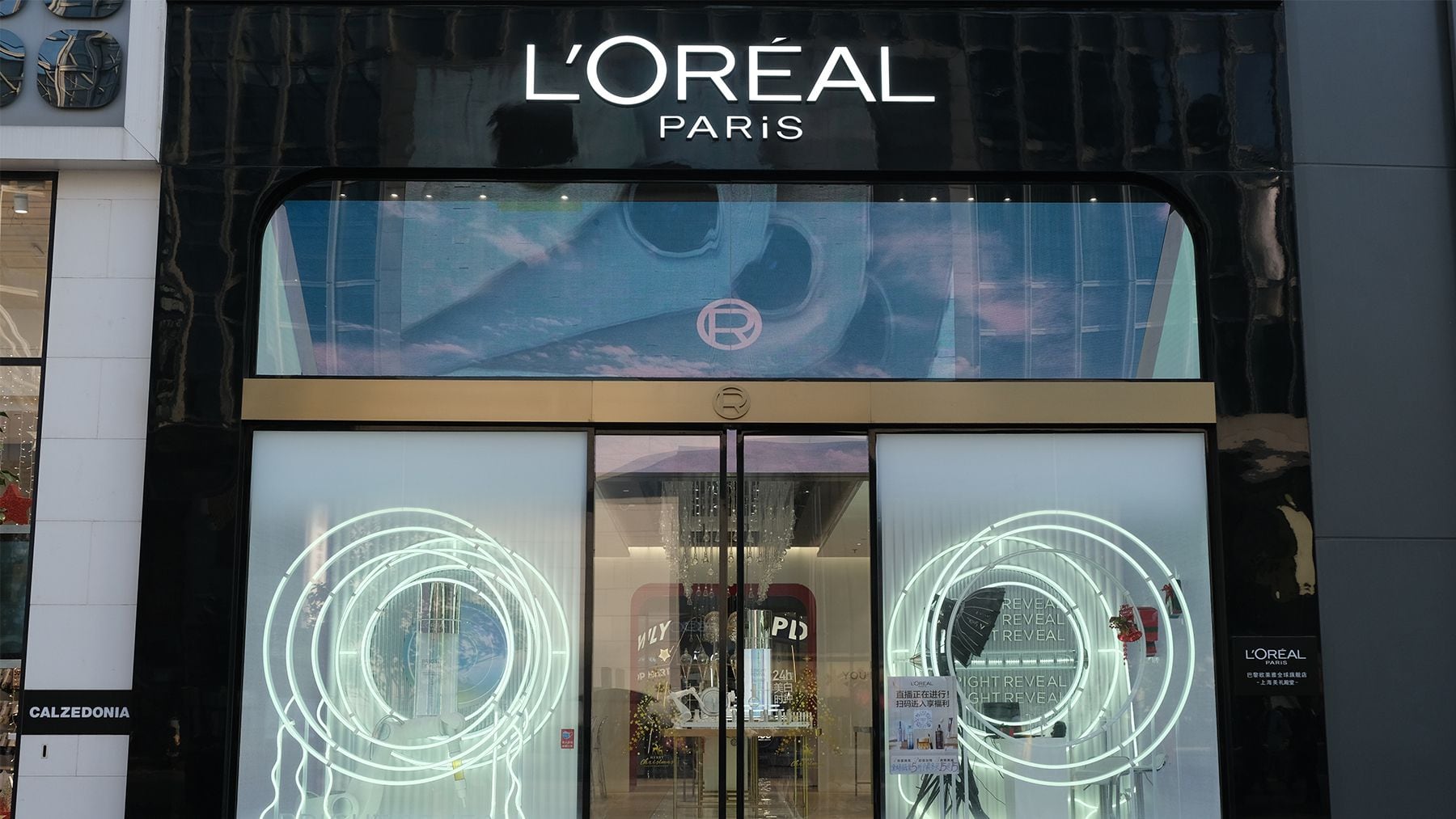
For international beauty conglomerates, the dream of guaranteed growth in China gave way to a sobering reality in 2023.
Recent earnings reports show that no global beauty company with a large China presence was spared in last year’s market slowdown, including beleaguered J-beauty companies like Shiseido and French market leaders like L’Oréal Group. But even as macroeconomic conditions dampened shoppers’ discretionary spending, domestic labels and a handful of leading foreign brands were able to defy market trends and grow due to an adept response to both product and pop culture trends. As signs now point to a possible 2024 beauty spending recovery, according to wealth management firm Bernstein, global brands face a more competitive market than in prosperous years past.
“Consumers are a bit more cautious,” said Lydianne Yap, research director at RTG Consulting Group. “Consumers are going to be reassessing their spending, including on categories such as beauty and cosmetics. If they do buy products, they’re going to be very focused on just the essentials.”
A Not-So-Pretty Year
In the last year, China’s consumer spending was hit by an economic slowdown, property market crisis and unemployment. International beauty brands felt the pain not only in travel retail but also domestic mainland China sales.
Estée Lauder Companies’ fiscal 2024 second quarter results reported on Feb. 5 stated that a global 8 percent net sales drop was due not only to Chinese consumers’ decreased travel retail shopping, but also to “ongoing softness in overall prestige beauty in mainland China.” L’Oréal Group reported a 5.8 percent sales decrease in North Asia (mainland China, Hong Kong, Taiwan, Japan and South Korea) for 2023, saying the region “continued to be impacted by the market softness in mainland China and the reset in travel retail.”
J-beauty was hit even harder due to a Chinese consumer boycott of Japanese brands as a result of Japan’s release of treated radioactive water into the Pacific Ocean. For example, Procter & Gamble CFO Andre Schulten said on the company’s fiscal 2024 second quarter earnings call that in China, a 34 percent sales slump for SK-II caused the conglomerate’s skin and personal care category to decline by “mid-single digits.” Shiseido’s China sales decreased by 21 percent in the fourth quarter of 2023, leading to a 5 percent year-over-year China sales decrease for the year.
Amid the challenges, several beauty labels significantly reduced or ended their China presence in the past two years: Too Faced and Huda Beauty shut down their Tmall shops in 2022, while E.l.f. Beauty withdrew from China in 2023. LVMH-owned Benefit Cosmetics closed all its China e-commerce shops in January 2024, limiting its distribution to Sephora.
“Global brands in China have been going after white space for the last 20 years in a market where performance was fueled by market growth,” said Jacques Roizen, the managing director of consulting at Digital Luxury Group. “Historically, brands have never really had to understand China. It was a black box that was printing money.”
Though a turnaround may be on the horizon — Bernstein recently reported that online beauty spending grew by 58 percent in January, utilising data from market research firm Moojing Market Intelligence — the era of low-hanging fruit may be over.
According to Roizen, international beauty brands must shift their strategy in China from speed toward optimization as market conditions change. While an earlier mindset was focused on rapid expansion to cash in on skyrocketing consumer spending, he said brands should focus on securing existing market share, spend allocation and ROI. In order to do that, global teams must take more time to understand the cost-benefit analysis behind their local teams’ commercial strategies.
“Global teams coming to China twice or three times a year for five days” is not enough, he said.
Another refrain from local market experts is that global brands must empower China-based teams, enabling them to better respond to nuanced changes in consumer behaviour and new trends rather than compelling them to seek permission from headquarters for minor decisions.
The Bright Spots
Though many international brands struggled, some local players came out as winners. Skincare brand Proya achieved 32 percent operating revenue growth in the first three quarters of the year, according to its most recent earnings report, and ranked as the number one beauty brand for Tmall Singles’ Day sales in Nov. 2023, ahead of L’Oréal Paris. According to experts, brands should look to Chinese labels for successful strategies.
“Being a C-beauty brand means that they are better at marketing to Chinese consumers; they understand what the consumers are looking for; they’re better at rolling out collaborations that resonate with their end consumer. It’s a little bit tougher for international beauty brands to be able to always have their finger on the pulse,” said Yap, noting that Proya quickly used social media skincare trends taking off on Xiaohongshu and other platforms such as the “Morning C, Evening A” catchphrase that had Chinese skincare enthusiasts buying up vitamin C products to apply in the morning and vitamin A for the evening. A similar trend gaining traction is “ABC Skincare,” which calls for incorporating AHA, vitamin A and vitamin C into one’s routine.
Staying on the pulse of customer behaviour requires an agile supply chain as well as a marketing strategy and distribution plan that can quickly respond to rapidly changing trends, according to experts. All this must be done, of course, without diluting brand positioning.
One brand able to navigate the market successfully last year was L’Oréal Paris, which was able to use its local supply chain, China-based innovation centre and a collaboration-focused marketing strategy to achieve 5.4 percent sales growth. Operating manufacturing in China especially benefited the brand in a market where beauty trends move fast.
“Consumers get bored very quickly. You need to be always coming up with new products that address the new concerns or just things for them to get excited about,” said Yap.
L’Oréal Paris also “prioritises Chinese consumers’ needs and working with all the celebrities that make sense, making sure their products are constantly upgraded,” said Yap. For example, the brand launched a second iteration of its Age Perfect Collagene Royal Cream in 2023. With the ingredient “recombinant collagen” trending online in China, the product became the top-selling face cream on Tmall, said Yap.
Zeroing in on the right pop culture trends is also crucial. For part of Estée Lauder Companies’ recent turnaround plan, it placed its namesake brand in the megahit TV show “Blossoms Shanghai” by legendary director Wong Kar-wai.
E-commerce platform focus is also a significant consideration for brands. As Tmall has lost ground to e-commerce competitors including JD.com, Xiaohongshu and Douyin – ByteDance’s mainland China version of TikTok – brands have diversified e-commerce platform distribution away from Tmall after their sales on the platform declined. Estée Lauder Companies’ earnings report noted that on Douyin, its Singles’ Day sales “more than doubled” and “offset” a net sales decline on Tmall.
After a year of lagging sales, brands turned to dramatic promotions for the November Singles’ Day shopping period. While premium and luxury brands “tend to avoid deep price discounts on their official brand stores,” said Yap, free gifts with purchase often provided the equivalent of a 40 to 60 percent discount. In a promotion with top beauty livestreamer Li Jiaqi (aka Austin Li), Estée Lauder gave away 37 ml in minis of its Advanced Night Repair serum with the purchase of a 30 ml bottle. La Mer, Shiseido and Lancôme also offered big gift-with-purchase incentives. But for brands with luxury positioning, these promotions come at a cost.
While many of these offers were likely part of brands’ year-end attempts to shore up sales results, said Roizen, he recommended brands get on a “promo detox program, fast. If you discount your brand, at some point, consumers adjust their mindset and their value perception.”



